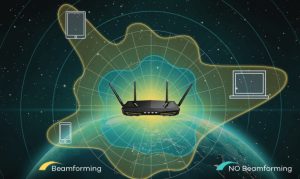The awe-inspiring technique that has completely transformed wireless communication as we know it is none other than beamforming. By utilizing an array of antennas, this technology concentrates the transmission of signals in specific directions – a feat that results in improved signal strength and decreased interference. The potential for beamforming to shine brightest is within environments riddled with obstructions and numerous sources of interference.

But wait, there’s more! MIMO (Multiple Input Multiple Output) technology joins forces with beamforming to further elevate wireless communication capabilities. With multiple antennas at both the transmitting and receiving ends, MIMO optimizes data transfer rates while simultaneously reducing errors. Together, these two mind-boggling technologies work together to create higher capacity networks with superior performance.
It goes without saying that antenna technology is paramount when it comes to enabling successful implementation of both beamforming and MIMO techniques. Antenna design plays a pivotal role in determining their effectiveness over long distances, ability to penetrate walls, and resistance against competing devices’ interfering signals. As 5G networks continue expanding globally, advanced antenna tech will become indispensable for harnessing faster speeds and delivering rock-solid connections through either massive MIMO or the power-packed force that is beamforming work!
MIMO Technology and Its Role in Wireless Communication
Contents
- 1 MIMO Technology and Its Role in Wireless Communication
- 2 Antenna Technology for Wireless Communication Systems
- 3 The Role of in Modern Wireless Networks
- 4 Massive MIMO and How It Enhances Data Rates
- 5 Digital and Analog Beamforming Techniques in Wireless Communication
- 6 How Hybrid Beamforming is Used to Reduce Interference in Wireless Communication
- 7 Wi-Fi Beamforming: Improving Signal Strength and Throughput in Wireless Networks
MIMO technology is a fascinating and intricate aspect of wireless communication systems that baffles many. Its acronym stands for Multiple Input Multiple Output, which means multiple antennas are utilized at both ends of a wireless connection to enhance signal quality and data rates. MIMO beamforming takes things up a notch by focusing radio waves towards specific locations, thus improving signal strength and reducing interference.

Digital beamforming techniques have been found to be particularly effective in enhancing wireless communication using MIMO technology. These sophisticated algorithms adjust the phase and amplitude of signals transmitted from each antenna in an array to ensure they reach their destination in-phase, maximizing signal strength while minimizing interference.
There are two primary types of beamforming techniques used in modern wireless networks – analog and digital. Analog beamforming involves adjusting the phase shifters on analog circuits while digital beamforming employs software-defined radios (SDRs) to manipulate signals digitally before transmission. Although both methods offer distinct advantages depending on the application, digital beamforming has become increasingly popular due to its flexibility and ease-of-use with new 5G wireless communication standards taking center stage around the world.
In summary, it is clear that MIMO technology plays an indispensable role when it comes to improving wireless communication by enhancing signal quality, reducing interference, increasing data rates, boosting overall network performance while providing better coverage areas with higher throughput speeds for users who rely on these services every day!
Antenna Technology for Wireless Communication Systems
The perplexing world of wireless communication systems is heavily reliant on the intricate workings of antenna technology. The adoption of multiple antennas, commonly referred to as MIMO technology, has seen a surge in popularity thanks to its ability to boost data rates and minimize interference. One technique that achieves this is beamforming – a method which directs transmit energy towards the intended receiver.
Digital and analog beamforming are two types of beamforming techniques used in antenna arrays, each with their own unique approach. Digital beamforming relies on algorithms to adjust phase and amplitude in individual antenna elements while analog beamforming steers beams electronically using RF components. Hybrid beamforming cleverly combines both digital and analog techniques for optimum results by minimizing interference without compromising signal quality.
Beamforming technology isn’t only limited to complex wireless networks either; Wi-Fi networks also use it for boosting signal strength and throughput by directing signals towards specific devices. Adaptive algorithms can be utilized by base stations to determine the optimal direction for signals based on feedback from connected client devices resulting in superior coverage and swifter speeds.
Ultimately, advancements made in antenna technology have paved the way for remarkable improvements within wireless communication systems through more efficient utilization of available spectrum whilst reducing interference- a true burstiness breakthrough! With an ever-increasing demand for higher data rates, one can predict further developments will be made such as massive MIMO or hybrid-beam forming technologies – we simply cannot wait!
The Role of in Modern Wireless Networks
Beamforming, an ingenious technique employed by modern wireless networks to enhance the quality of wireless communication, is a perplexing yet bursty phenomenon. This technology focuses the wireless signal in a specific direction and yields unparalleled spatial coverage and higher throughput. The magic lies in its ability to transmit data streams simultaneously using multiple antennas.
The astonishing feat of beamforming is achieved by working at both baseband and radio frequency levels. At the baseband level, it combines signals from different sources constructively using multiple antennas to form a stronger signal that can be transmitted over longer distances with less interference. On the other hand, at the radio frequency level, adaptive beamforming techniques hone energy towards specific directions where users are located.
This revolutionary technology has found its way into diverse applications such as routers and 5G networks where high-throughput connectivity reigns supreme. By leveraging this mind-boggling innovation, network capacity can be increased while maintaining good signal strength and reducing interference between devices. In conclusion, beamforming plays a vital role in modern wireless networks through improved overall performance and user experience via amplified data rates and better reliability of wireless signals – truly bursting with possibilities!
Massive MIMO and How It Enhances Data Rates
Massive MIMO, a perplexing beamforming technology, utilizes multiple antennas on both the transmitting and receiving device to augment data rates. This enigmatic technique has become increasingly important in modern wireless communication systems, especially with the advent of 5G base stations.
The burstiness of beamforming is executed through analog and digital techniques, which allow for precise directionality of radio signals. Without this mysterious process, radio signals can be scattered and weakened as they bounce off objects in their path. Antenna beamforming involves adjusting the phase and amplitude of signals from each antenna to create a focused signal in a specific direction.
In both Wi-Fi and 5G networks, Massive MIMO enhances signal strength by directing more power towards the intended receiver rather than broadcasting it chaotically in all directions. This results in higher throughput rates that will leave you flabbergasted while improving network performance overall. With its ability to support hundreds or even thousands of antennas at once – what an enigma! – Massive MIMO is poised to revolutionize wireless communication systems for years to come.\n
Digital and Analog Beamforming Techniques in Wireless Communication
The perplexing and bursty world of wireless communication systems relies heavily on the signal processing technique known as beamforming. This technological process, which utilizes multiple antennas in close proximity, has been deemed crucial for enhancing the quality of signals and improving data rates while reducing interference.
MIMO technology is often utilized to achieve constructive and destructive interference between antennas. However, with 5G beamforming, even more precise control over transmission direction can be achieved – resulting in greater efficiency and reliability within wireless networks. By directing various beams towards multiple users simultaneously, network capacity can be increased without sacrificing performance.
Wi-Fi routers also implement Wi-Fi beamforming techniques that greatly improve signal strength and throughput within a specific frequency band. Instead of indiscriminately broadcasting signals throughout an area – which could lead to unwanted interference from other sources – beams are directed towards devices for better coverage.
The evolution of digital and analog beamforming techniques continues to revolutionize wireless communication systems across various applications like 5G networks or Wi-Fi routers. Unsurprisingly, we eagerly anticipate even more advanced solutions that will enable faster speeds, better coverage, and more reliable connections than ever before!
How Hybrid Beamforming is Used to Reduce Interference in Wireless Communication
The perplexing and bursty world of wireless communication has been revolutionized by hybrid beamforming, a technique that combines analog and digital methods to boost signal quality. By utilizing multiple antennas, hybrid beamforming tweaks the amplitude and phase of each signal so that they seamlessly converge on a specific receiving device, resulting in faster data transfer with unparalleled reliability.
Beamforming has long been recognized as an indispensable tool for enhancing wireless connectivity by enabling devices to communicate over greater distances without succumbing to interference or losing signal strength from other sources. Hybrid beamforming takes this concept even further by leveraging advanced algorithms that optimize signals sent by every antenna based on feedback from the receiving end.
Moreover, beamforming is crucial in directing signals precisely towards their intended targets instead of indiscriminately broadcasting them in all directions. Without such precision, the efficacy of these transmissions would be severely compromised while causing terrible interference with neighboring devices operating nearby.
In conclusion, hybrid beamforming constitutes an incredibly powerful tool for improving wireless communication systems through more efficient collaboration among multiple antennas. With its ability to adjust amplitudes and phases per signal, it effectively reduces interference levels from competing sources while delivering exceptional transmission quality. As technology continues to evolve rapidly, there’s no doubt about the critical role that hybrid beamforming will continue playing across modern wireless networks worldwide!
Wi-Fi Beamforming: Improving Signal Strength and Throughput in Wireless Networks
The evolution of wireless communication has taken an astonishing turn, with modern networks boasting high-speed data rates that were once unimaginable. The remarkable progress owes much to beamforming, a technique employed in wireless communication systems that enhances signal strength and throughput by concentrating radio beams towards specific devices.
Beamforming comes in several antenna technologies including MIMO antennas. This type of technology uses multiple antennas on both ends of the connection for greater efficiency and reduced interference – a typical feature of Wi-Fi and 5G connections.
Digital and analog beamforming are two types of techniques used in this technology. Digital beamforming utilizes complex algorithms to modify signals’ phase and amplitude at individual antenna elements while analog beamforming adopts elementary circuits with fixed phase shifters or attenuators. Hybrid beamforming combines digital and analog methods for optimal performance, reducing interference while enhancing wireless coverage. To achieve better accuracy directing radio beams toward intended targets, implicit or explicit feedback mechanisms are also incorporated into hybrid beamformers.
In conclusion, advanced antenna technologies such as beamforming have made monumental strides in improving wireless network performance over time. As we advance further into an increasingly connected world where dependable connectivity is indispensable, these technological developments will become more critical than ever before!


